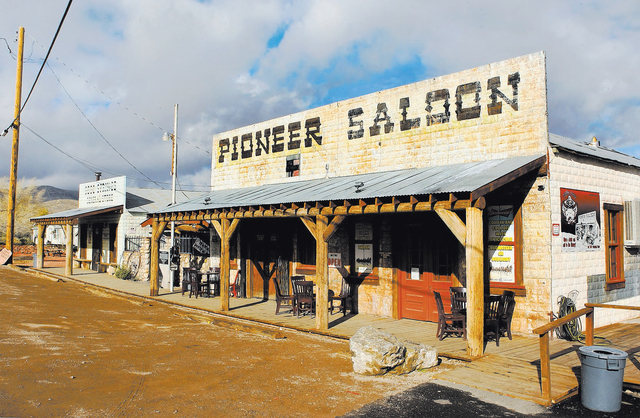Now a ghost town, ruins recall Goodsprings’ heyday
Once the center of the richest mining district in Clark County, Goodsprings now is listed as a ghost town. During its heyday in the early decades of the 1900s, Goodsprings was home to several hundred people. Today, about 230 residents enjoy the serenity of desert and mountains away from the urban bustle of the Las Vegas Valley about 30 miles to the north.
To reach Goodsprings, drive south from Las Vegas 20 miles on Interstate 15. Turn south toward Jean at exit 20, then turn right onto state Route 161. Follow this paved road 7 miles west to Goodsprings.
In typical Nevada boomtown fashion, mining dictated what was important in Goodsprings. Discoveries of valuable minerals in the area were first made in the 1850s when the Mormons settled along Las Vegas Creek. They built the Old Mormon Fort and farmed near the available water but also surveyed the surrounding desert and mountains for other resources. The settlers established a lead mine near Mount Potosi a few miles from the future site of Goodsprings.
The discovery of gold at Mount Potosi encouraged prospectors, who found a variety of minerals in the vicinity. Sporadic mining attempts led to the establishment of the Yellow Pine Mining District with several successful ventures taking gold, silver, lead, vanadium, platinum, copper and other minerals. Lack of transportation hampered development until railroads reached the area in the early 1900s.
Prospector and rancher Joseph Good often camped and watered his cattle at a water source in the foothills called Goodsprings, the name transferred to the mining camp that arose near the water. It grew rapidly with the arrival of the railroad from the coast to Salt Lake City. Soon, Goodsprings had a direct connection with construction of a narrow-gauge line to service area mills. The town thrived through World War I, declined after the war, then boomed again with the need for minerals during World War II. Mining declined after the war but has seen several brief revivals in the intervening decades.
Route 161 parallels the old railroad tracks into the foothills of the Spring Mountains, where traces of the old line’s roadbed remain. As you approach Goodsprings, look for foundations of one of the old mills on the left side of the highway and the Goodsprings cemetery on the right. In Goodsprings, many residents occupy newer dwellings, but a few vintage homes are still occupied. Rusted metal and weathered wood ruins mark many old building sites. The oldest structure in town, the 1866 Campbell cabin, is built of durable stacked native stone.
Goodsprings lost many downtown buildings to fire, the scourge of mining towns where wood was used to build quickly. It seemed the end of an era when a 1966 fire consumed the Fayle Hotel, for years a gathering spot for events and a nice place to stay. Vintage originals still standing include the 1913 Goodsprings Elementary School, the oldest school building still in use in Clark County, and the Pioneer Saloon, also built in 1913, the oldest original saloon in the county.
Listed on the National Register of Historic Places, the old school probably survived the fire thanks to its concrete construction. The school will be the focus of tours during the annual Goodpsrings Old-Timers’ Reunion, planned for next weekend. Organized by the Goodsprings Historical Society, the event features get-togethers, such as potluck lunches and the 29th annual Traditional Miners’ Breakfast, and a group photo.
The saloon survived because of its exterior and interior skins of pressed metal, features seen today on few existing buildings around the country. The saloon, its cafe and the tiny general store next door are all that are left of a once-thriving downtown that had several stores, many saloons, the hotel, a hospital, a newspaper and other amenities. A popular place, the saloon boasts a beautiful cherry back bar originally from old Rhyolite, antique decor, vintage photos and newspaper clippings, particularly of the 1942 airline crash on Mount Potosi that killed film star Carole Lombard, wife of movie legend Clark Gable.
Margo Bartlett Pesek’s Trip of the Week column appears on Sundays.







